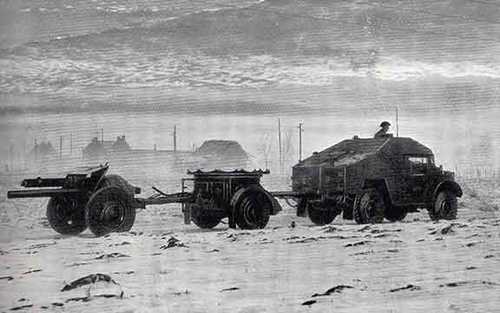
British Medium Artillery
During the ‘phoney war’ there was limited activity on the front line between France and Germany. Captain L. Twomey of 58 Medium Regiment, Royal Artillery kept an unofficial diary of a week he spent on attachment with the French artillery: WALDWIESSTROFF like all the villages hereabouts is completely empty of civilians and has been since the war started, the houses are all in great disrepair – there is debris and scrap iron, refuge, and untidiness everywhere. It is some four miles in front of the Maginot Line through which we passed on our way here. The village is occupied by the Groupement HQ. and one Battery (Troop), by the Battalion HQ (British) and a few soldiers of the Battalion, and by about a Company of French Infantry. The battery living in the village has its battle position in an orchard on the edge of the village. It is a tiny village but there is plenty of room for everyone on account of its emptiness. The battery (75 mm field guns) only shoot from their battle positions at night. All their shooting by day is from “Nomad positions” for which they hook a section out with farm tractors. They generally stay in the nomad position all day in case there is any shooting to be done at any time. There seems to be no fear of any Counter Battery fire and no fear of the village being shelled. At this stage everyone is afraid of “starting it” and there is a tacit agreement that villages are not shelled. A few days previously the Bosche put a stray round into a house in this village next door to the Groupement HQ; the Commandant got furious, rushed to the telephone and said “Je lui donnerai un cadeau”. He then shot up every Bosche village within range, firing 600 rounds. The Bosche has not repeated his misdemeanour. There is a general fear of reprisals in this curious stage of the war. We made our way back through the stickiest mud about 4.30 and came through the battery position, so stopped to give it a look over, It is about 2500 yds behind our FDs and almost in the village. In spite of the fact that they do not for a moment intend to give battle in this position they have taken a great deal of trouble over it and the gun pits are better than any British gun pits I have ever seen. The gun pits are made mostly above ground level, as there is a lot of water about, and they are built up of chopped boughs of trees of diameters varying from 2-10 inches with roofs and mud piled up around and on them. Inside they are beautifully made with home made wooden platforms of well sawn planks in which they have either cut circular runways for the wheels or nailed curved guides so that the gun when man handled by the trail must turn about its central axis with one wheel moving back and the other forward. Behind the platform the ground is dug away about 18inches depth as the 75mm can only elevate enough normally to shoot up to 5500 but its extreme range with the trail dug in is 9500. The arc for the trail is made by driving in stakes of about 2inches diameter in a circle all touching each other and forming the ledge of a step. The gun pits are all connected up by tunnels and the interval is only about 15yds. The French 75 was designed and first manufactured in 1897 and has only been altered in minor details since. It is probably the most famous gun in the world. The shell only weighs 12lbs, but they fire so fast that they probably put over the same weight as we do with our 18 pounders. The gun weighs only a ton and a quarter and can be manhandled by a detachment over any sort of ground and even in this sticky French mud. This and many of their regiments are what they call “portee” i.e. they run the whole gun up into a lorry and off they go in spite of iron tyres, as fast as you like. What impressed me most about it was it’s great simplicity in sights, elevating, and traversing gears and particularly the breech and firing mechanism. … Sanitation in this village just isn’t. Col. Lambert puts me in charge of the batmen and the drivers and we designed some. The results achieved would warm any M.O.’s heart!! We already have a fine palace made of elephant shelters, packing cases, barrels, etc and inside is a chair with its legs cut down and its seat taken out, over a deep trench. The legs stand on some goods firm boards, and beside it is a bottle of creosole. We also have a fine trench latrine and we hope it will be a good lesson in sanitation for the whole village!! They all, including the British, seem to do what they’re like where they like. Taken from: http://www.google.be/imgres?imgurl=http://ww2today.com/wp-content/uploads/2010/03/british-medium-artillery-1940. greetz,brummbar
This is a companion discussion topic for the original entry at https://ww2incolor.com/gallery/british-forces/45716/british-medium-artillery
